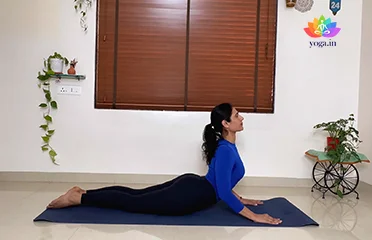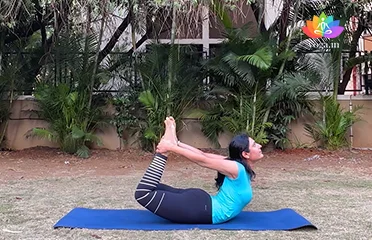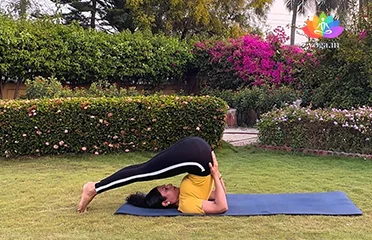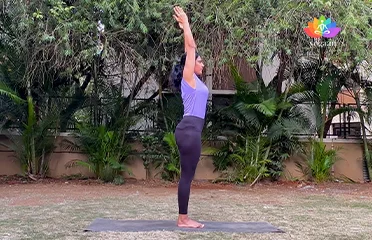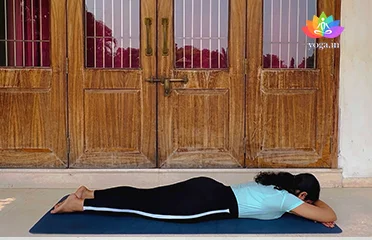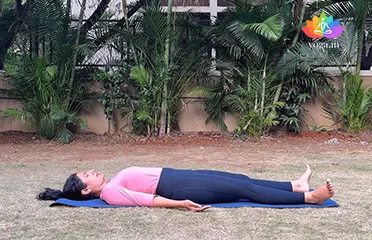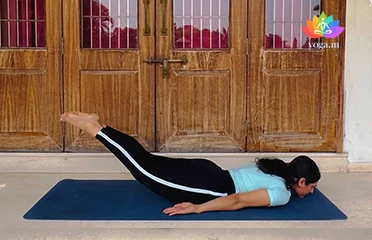Bhujangasana (Cobra Pose)
भुजंगासन / Cobra Pose
The Sanskrit name is derived from Bhujanga (भुजंगा) meaning cobra [�K]
Dhanurasana (Bow Pose)
धनुरासन / Bow Pose
The Sanskrit name is derived from Dhanur (धनुर) means bow and Asana [�K]
Halasana (Plough Pose)
हलासन / Plough Pose
The Sanskrit name is derived from Hala (हला) meaning plough and asana [�K]
Hastapadasana (Hand to Foot Pose)
हस्तपदासन / Hand to Foot Pose
The sanskrit name is derived from hasta (हस्त) means hands, pada (पदा) [�K]
Makarasana (Crocodile Pose)
मकरासन / Crocodile Pose
The Sanskrit name is derived from Makara (मकरा) meaning crocodile and [�K]
Savasana (Corpse Pose)
शवासना / Corpse Pose
The Sanskrit name is derived from Śhava (शव) meaning "corpse" and āsana [�K]
Shalabhasana (Locust Pose)
सलभासन / Locust Pose
The Sanskrit name is derived from Shalabha (शलभा) meaning locust and [�K]
Supta Padangusthasana (Reclining Posture
सुप्त पदंगुष्टासन / Reclining Posture
The Sanskrit name is derived from Supta (सुप्त) meaning 'supine or [�K]
How Yoga Can Help Cure Paralysis:
Paralysis is the loss of muscle function in part of your body, often accompanied by loss of sensation. Yoga can aid in the treatment and relief of paralysis by promoting better blood flow, reducing muscle stiffness, and enhancing overall physical and mental well-being. Through gentle postures, breathing exercises, and relaxation techniques, yoga can help improve mobility and restore some function.
Understanding Paralysis:
Paralysis is a condition where there is a loss of muscle function in part of the body. It can be caused by damage to the nervous system, particularly the spinal cord. Paralysis can be complete or partial and can occur on one or both sides of the body. It can affect just one area (localized) or be widespread (generalized).
Yoga’s Role in Relieving Paralysis:
Specific yoga practices can help alleviate the symptoms of paralysis by improving flexibility, strength, and coordination. These include gentle asanas (postures) that promote circulation and muscle engagement, pranayama (breathing exercises) that enhance oxygen flow and reduce stress, and meditation techniques that help manage pain and improve mental health.
Key Factors Contributing to Paralysis:
Several factors can contribute to the development of paralysis, including:
- Stroke: A sudden loss of blood flow to the brain.
- Spinal Cord Injury: Damage to the spinal cord that affects motor functions.
- Multiple Sclerosis: A disease where the immune system attacks the nervous system.
- Cerebral Palsy: A group of disorders affecting movement and muscle tone.
- Trauma: Physical injury that impacts the nervous system.
- Infections: Conditions like polio that damage nerves.
Symptoms of Paralysis:
Common symptoms of paralysis include:
- Loss of Movement: Inability to move parts of the body.
- Loss of Sensation: Reduced or no feeling in the affected areas.
- Muscle Atrophy: Shrinking and weakening of muscles due to inactivity.
- Spasticity: Stiff or tight muscles that resist movement.
- Difficulty with Coordination: Challenges in performing movements smoothly.
- Chronic Pain: Persistent pain in the affected areas.
- Bladder and Bowel Control Issues: Problems with urinary and bowel functions.
Treatment of Paralysis through Yoga and Pranayama:
Yoga and pranayama can be highly beneficial in managing paralysis. Some effective practices include:
Specific Yoga Poses:
- Tadasana (Mountain Pose): Improves posture and balance.
- Bhujangasana (Cobra Pose): Strengthens the spine and opens the chest.
- Setu Bandhasana (Bridge Pose): Enhances blood circulation and strengthens the back.
Pranayama Exercises:
- Nadi Shodhana (Alternate Nostril Breathing): Balances energy and calms the mind.
- Kapalbhati (Skull Shining Breath): Energizes the body and improves circulation.
Diet for Paralysis:
A balanced diet can help manage paralysis. Recommendations include:
- High-Protein Foods: Lean meats, fish, eggs, and legumes to support muscle repair.
- Anti-Inflammatory Foods: Berries, green leafy vegetables, and nuts to reduce inflammation.
- Hydration: Drink plenty of water to stay hydrated and support overall health.
- Omega-3 Fatty Acids: Found in fish, flaxseeds, and walnuts, these support nerve health.
- Fiber-Rich Foods: Whole grains, fruits, and vegetables to maintain digestive health.
Caution for Paralysis:
While practicing yoga for paralysis, it is essential to:
- Avoid Overexertion: Practice at a gentle pace to prevent strain and injury.
- Be Mindful of Pain: Stop immediately if any pose causes discomfort or pain.
Always consult with a healthcare provider before starting any new exercise regimen, especially if you have severe paralysis.
Contraindications for Paralysis:
Individuals with severe paralysis or significant muscle weakness should:
- Avoid Intense Yoga Practices: Vigorous exercises might exacerbate symptoms.
- Steer Clear of Certain Poses: Poses that require intense muscle control or balance may increase discomfort.
- Seek Professional Guidance: Consult a yoga therapist or healthcare professional for personalized recommendations.


